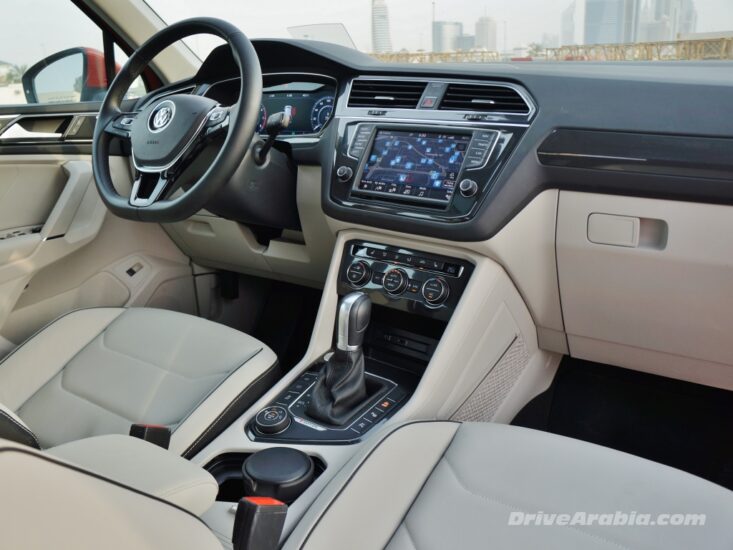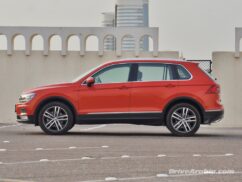2020 Volkswagen Tiguan 2.0 TFSI Sport
| The Good: – Conservatively handsome styling – Comfortable and fun to drive – High-end options available |
The Bad: – Smaller than direct rivals – No innovative storage solutions – Options drive up price |
The VW Tiguan, long the has-been player of the compact crossover segment due to its below-average size combined with its above-average price compared to rivals, received a new-from-the-ground-up makeover for the 2017 model year. Continuing unchanged since then, the new skin rejuvenated the model with more desirability (as much as crossovers can be), and even giving the appearance of being a more practical-minded replacement for the VW Golf GTI. Is the Tiguan still relevant since then though?
The Golf-based Tiguan is a handsome car, ushering in VW’s latest corporate styling at the time with clean styling cues and sharper corners. Arguably the optional R-Line pack looks best as it adds a nice aggressive body kit to the mix. However the non-kitted version is attractive in its own right, but too sedate to turn heads. In Sport trim, it comes with black unpainted plastic trim on the lower body, brushed metal roof rails, chrome grille and 19-inch wheels.

Inside, the cabin styling is simple and functional, with an available two-tone interior that combines soft-touch black upper trim with beige hard plastics. The optional leather upholstery matches the colour scheme, while slivers of satin-silver and piano-black trim round out the look. Admittedly, our test car is an older model featuring a different infotainment screen setup, but otherwise new models are identical.
Stepping in is easy, and the ambience is that of quality, except for the plastic door handles that crackle when you pull them. The well-bolstered front seats are power-adjustable. The rear bench seat split-folds, slides back and forth, and even leans back. Legroom is good enough in the back, but headroom is average. There are the usual cup-holders, door pockets and centre-armrest cubby. The boot space is also average, and the overall storage features lack innovation in a segment whose best offering is the ever-evolving Honda CR-V, although VW did save some space by fitting the subwoofer in the middle of the spare wheel under the boot floor.
That sub is part of the excellent 8-speaker audio system in this mid-spec trim, controlled via a capacitive touchscreen (6.5-inch or 8-inch depending on trim). Other available features include a panoramic glass roof, power-opening tailgate that works with a foot-wave, smart keyless entry and start, a full-LCD gauge cluster with navigation, a good dual-zone auto a/c with rear temperature control and vents, LED headlights and tails, and a host of active and passive safety features, although some of them may only be available on special order.

The base engine is a boosted 1.4-litre, but all the other trims get a larger 2.0-litre turbo four mated to a 7-speed dual-clutch automatic, making either 180 hp or 220 hp. The Sport we drove makes 220 hp at 4500 rpm and 350 Nm of torque at 1500-4400 rpm, similar to the Golf GTI. It’s enough to give the Tiguan 2.0 TFSI a 0-100 kph time of 7.7 seconds in our testing last July, although it’s claimed to be able to do 6.5 seconds. It’s also supposed to burn fuel at a rate or 7.8 litres/100 km, but we got 12.2 litres/100 km (8.2 km/litre) during our time with the car. The motor clearly has a tough time matching the optimistic rated figures with our weather and fuel quality, but it’s actually fine compared to rivals.
The Tiguan is entertaining to drive, with good low-end torque and mininal turbo lag, and a DSG automatic that behaves like it knows what it’s doing. However, some clunk from the gearbox can be heard when slowing down, and it’s normal.
The handling is great, with limited body rolls, predictable motions and good grip from the 235/50 tyres, although it’s not quite the Golf GTI-on-stilts that we were hoping for, as it understeers far earlier.
It’s pretty smooth on most roads, but a bit harsh over serious bumps due to the slightly-firm suspension tuning and the thinner tyres on the 19-inchers. It is reasonably quiet up to 100 kph, and progressively gets noisier after that.
Interestingly, while the Tiguan isn’t meant to be a serious offroader, it does fine on desert sand if the motor is kept on the boil, and can go pretty far in capable hands. Due to the lack of low-range gearing and ground clearance, you cannot go too far though if you don’t know what you’re doing.
The Tiguan continues to be one of the more premium offerings in the compact crossover segment, with its German sophistication and performance. However, this is a segment that cries out for maximum practicality and value-for-money above all else, and the VW will continue to be a bit player in this region.
| Price Range: Dh 141,000-150,000 Current Model Introduced in: Body Styles: Engines: Transmissions: Setup: Suspension: |
Brakes: Front: discs Rear: discs Curb Weight: Length: Wheelbase: Top Speed: Test Acceleration 0-100 kph: Observed Test Fuel Economy: |
















Comments
Marwan
I own the previous generation Tiguan in my home country and I beg to differ that the size is so good specially for congested cities and the driving dynamics. With every manufacturer trying to add size to their vehicles it is becoming very insane where you have the 3 serieis is larger than the 5 series 2 generations ago. It is a joke! Not to mention the disappearance of coupes like Honda Accord etc. Not every client is a family with 3 kids and stroller so you need as journalists to keep fun cars alive and don’t repeat what all others say. Who wants bigger size there are plently of them
On a side note this generation is not as attractive as the previous one imo
Alton
Are you kidding? Families are people who buy crossovers. You mention coupe and small car then why are you looking at crossover if you don’t need space.